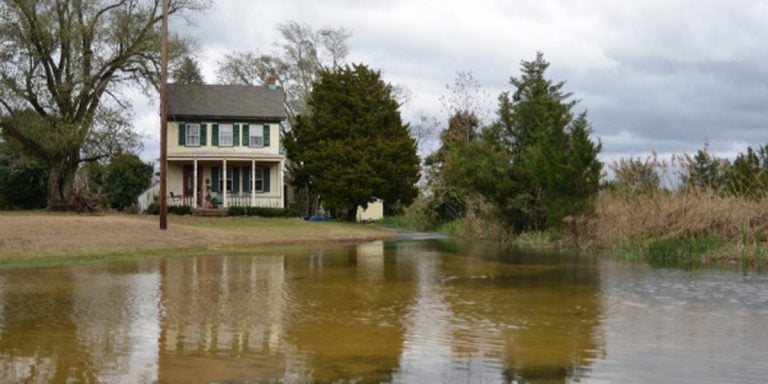Defend or Retreat? Cumberland County wrestles with rising seas

The water crept up on this house in Maurice River Twp. the morning after Superstorm Sandy. (Bas Slabbers/for NewsWorks)
Like any homeowner, Meghan Wren expects to be able to come and go from her property any time she wants, but in coastal Cumberland County, it’s not that simple.
Wren, who lives amid the county’s vast salt marshes abutting the Delaware Bay, has to think about whether it’s safe to drive a particular stretch of road near her home if there’s a high tide combined with a full moon or heavy rain.
Under those conditions, a quarter-mile stretch of Money Island Road can be covered with up to a foot of seawater, which is creeping across the marshes with increasing frequency as ocean levels rise.
Wren has to time her trips along the road to make sure she’s not blocked by floodwaters on the way to her job as executive director of the nonprofit Bayshore Center at Bivalve, or on the way home.
One night in 1999, she spent all night in her car on the road after a high tide, a full moon, and 13 inches of rain caused such deep floods that she was unable to get home or return to her office, so simply parked on an unflooded stretch of road, and waited for the waters to recede. More often, she has to wait an hour or two on the road until the water level is low enough to drive through.
Wren says the flooding has been an increasingly frequent occurrence since she moved to the area in 1997, and she blames rising sea levels, whose effect is sometimes amplified by the tides, the moon, and the wind.
“When your road floods like this, you can’t not think about sea-level rise,” she said in an interview at Money Island marina. “When you are driving through that to get to work, you can’t ignore it.”
Wren used to drive a Toyota Prius but its electrical system got ruined by 18 inches of water in her driveway during a storm on December 21 last year. So she now has a Ford Escape which is eight inches higher than the Prius, giving her a better chance of getting through floods.
Rising TidesThe flooding faced by Wren and her neighbors reflects a county-wide struggle to deal with rising seas that are increasingly inundating low-lying coastal areas; flooding roads and previously fertile land; infiltrating septic systems, and killing trees that can’t live in salt water.
Almost a year since Superstorm Sandy devastated large areas of the Jersey shore, coastal villages like Money Island — an isolated community of about 40 houses some 15 miles south of Millville — are grappling with the less-dramatic but profoundly challenging reality of what to do about rising seas.
According to the latest Rutgers University projections, published by the state’s Department of Environmental Protection in August, sea levels along the New Jersey coast are expected to rise by 17 inches by 2050 and 44 inches by the end of the century as ocean volumes rise in response to melting polar ice caps in the warmer global climate. Storm surges could be higher, as shown by Sandy, which produced a six-foot surge in the back bays, the DEP said.
The predicted rise along the mid-Atlantic coast is about twice the global rate, because the region’s land is sinking at the same time waters rise. In Delaware, between 8 and 11 percent of that state’s land mass could be inundated by 2100, according to official projections.
At Gandys Beach, about a mile south of Money Island, Jim Shaw is still repairing the siding on his beachfront house after Sandy, and fears the next storm but is equally worried about rising seas.
“High tide used to come up as far as the deck,” he said as waves broke against the pilings supporting a new deck that replaces one destroyed by Sandy. “Now, it goes all the way to the end of the house about 40 feet away. Every year, we have less sand.”
Shaw, 70, a retired machinist who bought the house in 1999, said he wants to see bulkheads built out into the ocean to reduce the impact of future storms. But he doesn’t know what can be done about rising oceans, and just hopes the elements will allow him to live in his house for the next decade. “I can stay for another ten years,” he said.
Shaw’s ability to do so may depend on a variety of protective measures now under consideration by state and local officials. They include rebuilding the dikes and levees that previously protected the salt marsh when it was used for making hay, replenishing beaches, and building bulkheads, groins, and jetties to control tidal movements.
But it won’t be feasible to defend every stretch of coastline from the rising waters, and in some cases, people may simply have to retreat, Wren said. That option is widely regarded as a last resort, especially among homeowners of modest means who have sunk their life savings into shore houses, and have been visiting or living there for generations.
“There may be some places where it doesn’t make sense to invest to protect small installations,” she said. “But I would not want to be the one to make that judgment.”
Saving What Can Be SavedTim Dillingham, executive director of the American Littoral Society, said officials and residents should abandon the idea that the whole coastline of areas like Cumberland County can be defended from rising waters, and should focus instead on what can feasibly be saved, while working to preserve environmentally important coastline.
“We should be identifying what is indefensible,” he said.
Public money designated for Sandy recovery and sea defenses should be used to buy out the most vulnerable homeowners, Dillingham said, rather than to build new infrastructure such as sewer lines that would support additional development, as proposed by some local politicians.
But in a sign of local divisions over how to prepare for rising seas, the Cumberland County Board of Freeholders recently passed a resolution calling on the state to divert funds earmarked for the buyout of about 350 Cumberland County homes to instead fund projects like new wastewater plants to protect the shore.
For those advocating retreat, a possible candidate is Bay Point, a remote shore community of about two dozen homes – all of which are built on pilings — where about 10 homes were lost to Sandy.
Mike Nelson, one of a handful of full-time residents of Bay Point, and one of those who lost his home in the storm, said high tides are getting higher, and flooding is increasing. At full moons, roads are more likely to be covered, cutting off the community from the outside world at times, he said. Cars are getting damaged by the salt water.
Nelson, 57, a retired maintenance supervisor with the Delaware River Port Authority, said he’s planning to retreat by rebuilding on the community’s north side which he said is more sheltered from storms. For now, he’s living in a trailer with his wife, his grandson, and his sister-in-law.
“I’m not going to rebuild in that location,” he said, referring to his ruined bayside house.
Staying PutBut Nelson said he has no plans to move away from Bay Point, where his family has been living or visiting since 1947, and where he supplements his retirement income by fishing, and crabbing.
“I have no interest in leaving,” he said. “This is my choice to be here, and I’m prepared to do what I have to.”
Officials who offer advice on recovering from Sandy and planning for sea-level rise are urging coastal residents to use mapping tools published by Rutgers University, the DEP, and soon, Climate Central, a Princeton-based group.
The tools overlay local facilities such as schools and hospitals with anticipated inundation, allowing officials to plan for their defense or retreat, said Chris Sturm, senior director of state policy for New Jersey Future, a nonprofit that’s working on the issue.
“Sea-level rise is gradual, and the same is true for investing in infrastructure,” Sturm said. In view of the long lead time needed for building new roads, bridges or drains to cope with rising seas, she urged officials to make plans sooner rather than later, and to budget for them.
On the east side of Cumberland County’s Maurice River, the town of Leesburg experiences flooding on three roads every time there’s a full moon, said Kathy Ireland, deputy mayor of Maurice River Township.
Some residents have had saltwater intrusion into their septic systems, while the rising influx of seawater is killing increasing numbers of trees, known locally as “ghost forests,” stands of which can be seen on the road between Heislerville and Delmont.
In a bid to stop the tide reaching the woods, the township is considering building an earthen berm for several miles along the line between the woods and the salt meadows, Ireland said.
Despite the flooding, most people want to stay and adapt their lives to the new conditions, even if the state offers to buy them out, Ireland said. “Just a few people would be willing to sell and move,” she said.
Moving is not an an option for Meghan Wren, who is heavily invested in the community where she has lived for 16 years.
“I’ve thought about it intellectually,” she said. “But I’m not ready for it emotionally.”
_______________________________________________________
NJ Spotlight, an independent online news service on issues critical to New Jersey, makes its in-depth reporting available to NewsWorks.
WHYY is your source for fact-based, in-depth journalism and information. As a nonprofit organization, we rely on financial support from readers like you. Please give today.




